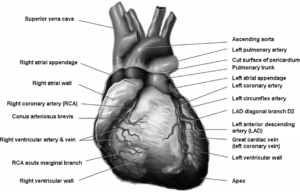A heart attack, or myocardial infection, occurs when blood flow to your heart is blocked.
Heart attacks are caused by blockages in the coronary arteries, the blood vessels that carry oxygen-rich blood to your heart.
Heart attack is a medical emergency. Blocked blood flow to your heart damages the heart muscle.
If blood flow is not restored quickly, the heart muscle will begin to die.
When the blood flow to your heart is completely cut off or can be severely reduced when blood clots in any of the arteries that are blocked by the first plaque build up.
Plaque is a combination of fat, cholesterol and other substances that can build up in the lining of your artery walls.
This construction is called atherosclerosis, or “hardening of the arteries.”
The formation of plaque in the arteries leading to your heart is known as coronary artery disease (CAD), and is a major risk factor for heart attack.
The Difference Between Heart Attacks and Cardiac Arrest
The term “heart attack” is often misused for the term heart attack – when your heart suddenly stops beating.
Cardiac arrest is caused by electrical impairment (ventricular tachycardia or ventricular fibrillation). It is often fatal if immediate steps are not taken to restore and stabilize heart rhythm and pumping function.
Although a heart attack can lead to a cardiac arrest, it does not always stop your heart from beating during a heart attack.
Heart Attack Statistics
According to the Centers for Disease Control and Prevention (CDC), people in the United States have a heart attack every 40 seconds.
According to the CDC, 1 in 5 heart attacks is silent, meaning the person is not aware of it and does not seek immediate medical attention.
According to a January 2018 report by the American Heart Association (AHA), published in its journal Circulation, approximately 1 million people in the United States suffer a heart attack each year.
It has an estimated 720,000 first-time heart attacks and 335,000 recurrent heart attacks.
The average age of first heart attack is 65.6 for men and 72.0 for women, according to the AHA.
Less than 10 percent of heart attacks are fatal, according to Harvard Medical School. The biggest reduction in heart attack deaths in recent decades is due to the widespread use of treatment in the early stages of a myocardial infection.
Still, the broader category of heart disease is the leading cause of death among adults in the United States, accounting for 1 in 3 deaths overall.
Coronary artery disease is the deadliest form of heart disease, followed by stroke, heart failure, hypertension, other arterial diseases and other cardiovascular diseases.
Worldwide, heart disease is also the leading cause of death, accounting for more than 17.9 million deaths in 2015.
Heart disease does not affect all ethnic and racial groups equally. According to the AHA, the death rate from heart disease for African Americans is one-third higher than the overall American population.
Native Americans and Alaskan Native Americans are also at higher risk of dying from heart disease, accounting for 36% of deaths before the age of 65, compared to only 17% of the total American population. Percent.
